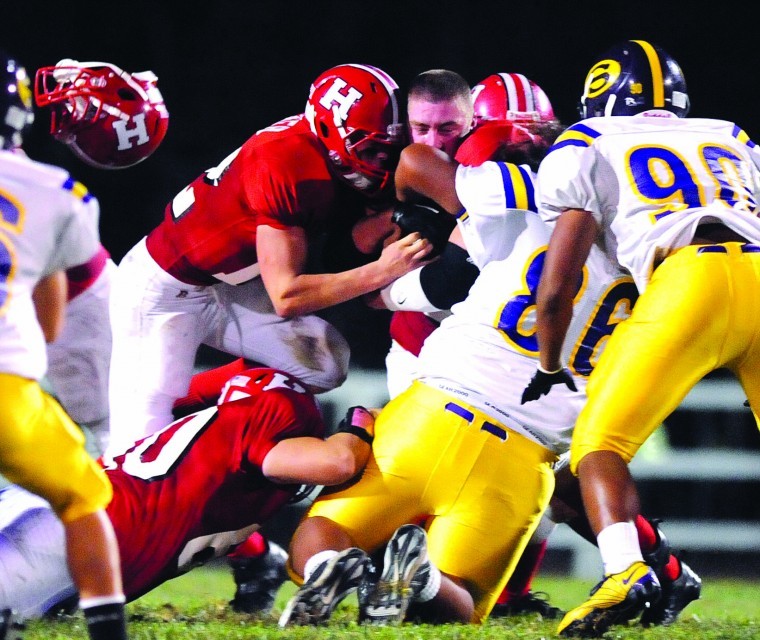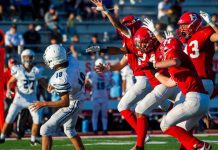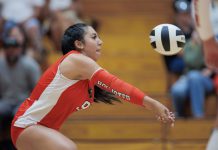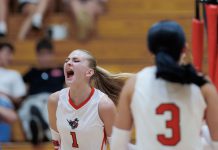With national attention turned to head injuries in sports – specifically concussions – new California legislation that went into effect on Jan. 1 will further regulate how high schools protect their athletes’ heads.
In other words, dings or minor head injuries are no longer minor, and that’s a welcomed sign for those in the medical profession and who take care of San Benito athletes.
“It’s a step in the right direction,” San Benito athletic trainer Dave Teri said.
The AB 25 bill, which was first introduced in the second half of 2010 and approved by Gov. Jerry Brown in October 2011, forces academic institutions to give a yearly information sheet, which will be signed and returned, to parents and students regardless of the sport. Also, when a student receives a concussion, they will automatically be removed from the sport and prohibited from returning until a licensed health care provider claims they are cleared from all symptoms.
The law won’t necessarily change how San Benito already handles concussions, said Tod Thatcher, the school’s athletic director, and the football team’s defensive coordinator. For the first time this past year, the football team – on recommendation from Central Coast Section officials and local health care provider Dr. Peter Coehlo – restricted players who were concussed from practicing or participating in team activities.
If a player was determined to have suffered a concussion – whether in practice or in a game, regardless of severity – a “six-day, no play” policy was introduced, Thatcher said.
“If a player suffered a concussion, he couldn’t play until after those six days,” Thatcher said. “That’s what we had this year.”
Now, the school is considering implementing the policy to all sports.
“Right now, that’s what we are looking at,” he said. “We are trying to develop a universal policy that all sports have to follow. Right now, we are just waiting on the legal department.”
The new law, though, will continue the school’s already watchful eye on head injuries, Teri said. The trainer, who has been with the school for more than 14 years, has seen the school become increasingly more worried about students receiving concussions.
“When I first started here, it was more about getting players on the field as quickly and safe as possible,” he said. “Now, it’s changed to where I have to protect the players from themselves. We do that a lot.”
That change started five to six years ago, when the school started to see an increase of head injuries in football and, specifically, wrestling, Teri said. Because of wrestling’s conditioning practices, which at times lowers fluid intake, the spinal cord was open to serious injuries.
“Once we started using the hydration test, that number started to go down,” Teri said. “But wrestlers are still going to get their heads thrown to the mat and they are still going to get knees to the head. That’s just the sport.”
Five years ago, if a player received a minor concussion they would usually return to the game.
“I don’t even know how many kids I sent back out there,” Teri said. “We don’t do that anymore, though.”
On a yearly basis, the school sees anywhere from 10 to 20 athletes receive concussions in a year. Sometimes an athlete receives more than one.
“It varies on the year,” Teri said. “This year we had about 15.”
With increased restrictions on how the school handles concussion, school officials have worries about how the students and parents react to a forced leave.
“We are worried about parents just finding doctors that will sign off on their kids the fastest,” Thatcher said. “The kids want to play, and the parents want them to play. We need to find something that protects the kids. It’s hard.”
It’s always possible that some students might knowingly hide their injury.
“I hope the kids and parents are starting to realize that this is a serious injury,” Teri said. “We need to do a better job of informing the parents and the kids.”
Information is one of the three pillars of the new bill. Before each school year or sports season, the school will add a concussion information form to their take-home packages.
The form will describe the symptoms of a concussion and outline the soon-to-come school policy in regards to concussions. Parents and students will be required to sign and turn it back into the school.
If a student gets concussed, which will be determined by Teri and Coehlo at games and practices, he or she must get approved by their own health care provider to return. Once the player returns, though, Teri will put the student through test to determine if he or she is ready to rejoin the team.
Coehlo, who gave a concussion presentation to coaches in the summer, did not return calls before press time.
The player will slowly be introduced into athletic activities, such as light cardio and weightlifting. If the players starts to suffer from side effects of the concussion, the activity will stop and start over.
It can take anywhere from a week to a couple of months.
Regardless of how long it takes for a the player to return, they won’t unless they are completely cleared.
“We want to make sure they are symptom free before they return,” Thatcher said. “If they are diagnosed, they won’t play.”
The school’s new concussion policy should be completed when the school reopens from winter break, Thatcher said.
“We are just finishing it up,” he said.
For more information on concussion visit the Center for Disease Control website.
Concussions:
Symptoms can last for days, weeks and longer. Concussions are a mild traumatic brain injury, usually caused from a blow to the head.
Symptoms include:
Headaches
Amnesia
Confusion
Loss of consciousness
Dizziness
Ringing in the ears
Loss of appetite
Nausea
info from the CDC










